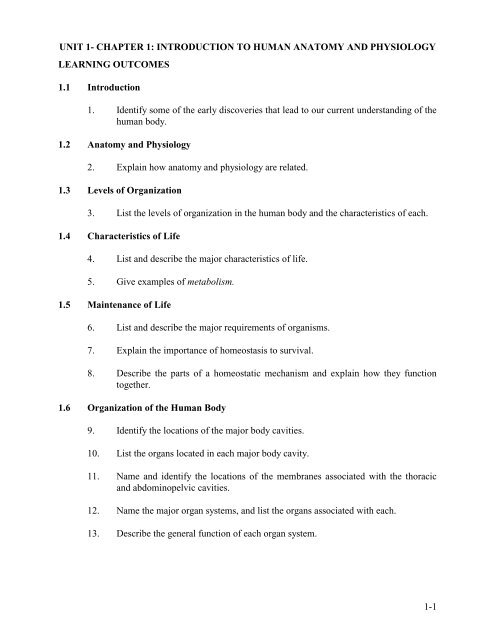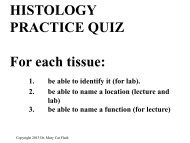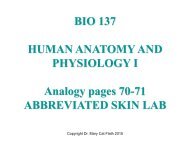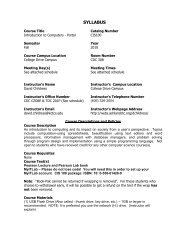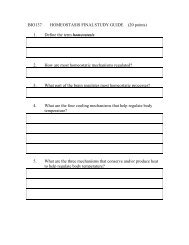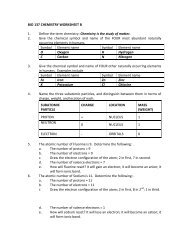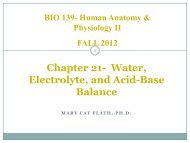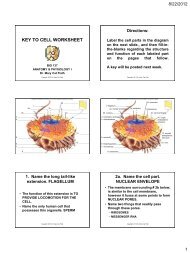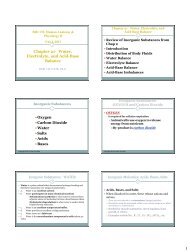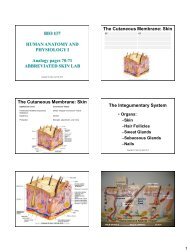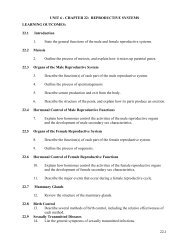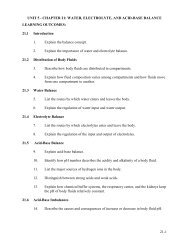CHAPTER 1: INTRODUCTION TO HUMAN ANATOMY ...
CHAPTER 1: INTRODUCTION TO HUMAN ANATOMY ...
CHAPTER 1: INTRODUCTION TO HUMAN ANATOMY ...
You also want an ePaper? Increase the reach of your titles
YUMPU automatically turns print PDFs into web optimized ePapers that Google loves.
UNIT 1- <strong>CHAPTER</strong> 1: <strong>INTRODUCTION</strong> <strong>TO</strong> <strong>HUMAN</strong> ANA<strong>TO</strong>MY AND PHYSIOLOGYLEARNING OUTCOMES1.1 Introduction1. Identify some of the early discoveries that lead to our current understanding of thehuman body.1.2 Anatomy and Physiology2. Explain how anatomy and physiology are related.1.3 Levels of Organization3. List the levels of organization in the human body and the characteristics of each.1.4 Characteristics of Life4. List and describe the major characteristics of life.5. Give examples of metabolism.1.5 Maintenance of Life6. List and describe the major requirements of organisms.7. Explain the importance of homeostasis to survival.8. Describe the parts of a homeostatic mechanism and explain how they functiontogether.1.6 Organization of the Human Body9. Identify the locations of the major body cavities.10. List the organs located in each major body cavity.11. Name and identify the locations of the membranes associated with the thoracicand abdominopelvic cavities.12. Name the major organ systems, and list the organs associated with each.13. Describe the general function of each organ system.1-1
UNIT 1- <strong>CHAPTER</strong> 1: <strong>INTRODUCTION</strong> <strong>TO</strong> <strong>HUMAN</strong> ANA<strong>TO</strong>MY AND PHYSIOLOGYLEARNING OUTCOMES1.7 Life-Span Changes14. Identify changes related to aging, from the microscopic to whole-body level.1.8 Anatomical Terminology15. Properly use the terms that describe relative positions, body sections, and bodyregions.1-2
UNIT 1- <strong>CHAPTER</strong> 1: <strong>INTRODUCTION</strong> <strong>TO</strong> <strong>HUMAN</strong> ANA<strong>TO</strong>MY AND PHYSIOLOGY1.1. <strong>INTRODUCTION</strong>A. Study of anatomy and physiology is an ever-developing science with a longhistory.1. See Fig 1.1, page 11 which dates back to 1543 AD.B. Greek and Latin form the basis for the language of anatomy and physiology.1.2 ANA<strong>TO</strong>MY AND PHYSIOLOGY:A. ANA<strong>TO</strong>MY = the study of the structure (morphology, form) of body parts.B. PHYSIOLOGY = the study of the function of body parts.C. These two sciences are closely related.1. Every living organism’s structures’ are organized in a particularfashion, in order to carry out a specific function.2. Structure determines function/ Anatomy determines physiology.3. See Fig. 1.2, page 12.D. Scientists use many tools to study anatomy. See Clinical Application 1.1, pages14-15: Ultrasonography and Magnetic Resonance Imaging: A Tale of TwoPatients.1.3. LEVELS OF ORGANIZATION:See Fig 1.3 and Table 1.1, page 13.A. Subatomic particles include the uncharged neutron, positively charged protonand negatively charged electron. Subatomic particles combine to form an…B. atom [i.e. Carbon (C), Hydrogen (H), or Oxygen(O)]. An atom is defined as thesmallest particle of an element. Atoms combine with (react with) other atoms toform a…C. molecule [i.e. molecular oxygen (O 2 ), carbon dioxide (CO 2 ), water (H 2 0)]. Amolecule is defined as a particle composed of 2 or more joined atoms. Moleculescombine with other molecules to form a...D. macromolecule (i.e. carbohydrates, lipids, proteins, nucleic acids). Amacromolecule is defined as a large molecule. Macromolecules combine withother macromolecules to form an...1-3
UNIT 1- <strong>CHAPTER</strong> 1: <strong>INTRODUCTION</strong> <strong>TO</strong> <strong>HUMAN</strong> ANA<strong>TO</strong>MY AND PHYSIOLOGY1.3. LEVELS OF ORGANIZATION (continued):E. organelle (i.e. cell membrane, nucleus, ribosomes). An organelle is defined as asmall organ of a cell, composed of two or more macromolecules, which performsa particular function. Organelles collectively compose a...F. cell. The cell is defined as the basic unit of structure and function of livingorganisms!Each cell has a set of organelles and performs a particular function (i.e. a redblood cell has a biconcave shape and is anucleate. This structure increases itssurface area, allowing for the transport of more oxygen.Some cells have all of the machinery that they need to live. See the amoeba, asingle-celled organism in Fig 1.4, page 17.Similar cells with some extracellular material are arranged into a...G. tissue (i.e. epithelia, connective, muscle, nervous). A tissue is defined as a groupof similar cells that performs a specialized function. Two or more tissuescombine to form an...H. organ (i.e. skin, heart, brain). An organ is defined as a structure consisting of agroup of tissues that performs a specialized function. Two or more organscombine to form an...I. organ system (i.e. integumentary, cardiovascular). An organ system is defined asa group of organs that act together to carry on a specialized function. The elevenorgan systems collectively form the...J. human organism. An organism is the most complex level of organization and isdefined as an individual living thing.1.4. CHARACTERISTICS OF LIFEA. Ten processes: See Table 1.3, page 16.1. Movement2. Responsiveness3. Growth4. Reproduction5. Respiration6. Digestion7. Absorption8. Circulation9. Assimilation10. Excretion1-4
UNIT 1- <strong>CHAPTER</strong> 1: <strong>INTRODUCTION</strong> <strong>TO</strong> <strong>HUMAN</strong> ANA<strong>TO</strong>MY AND PHYSIOLOGY1.5. MAINTANENCE OF LIFEA. Requirements of Organisms See Fig 1.5 and Table 1.4, page 17.1. nutrients for energy2. oxygen for cellular respiration3. water for most metabolic reactions, lubrication, etc.4. heat to maintain 37 o C body temperature, enzyme action5. pressure for breathing and filtering blood through kidneysB. Homeostasis See Fig 1.6, page 18.1. Definition = the tendency of an organism to maintain a relatively stableinternal environment despite external changes.o This is done by keeping conditions in a homeostatic range compatiblewith life, near a “set point” value.2. Most life processes and metabolic reactions work to maintain homeostasis.3. Most homeostatic mechanisms are regulated by negative feedback (seeexample below), which bring conditions back toward set point.4. Sometimes conditions are purposely moved away from the set point. Thisis called positive feedback.a. Examples include “fight-or-flight” and blood clotting discussed inchapters 13 and 14, respectively.5. All homeostatic mechanisms have three components in common.a. Receptor – senses change in environmentb. Control Center – regulates set point of variablesc. Effector – organ that acts in response to changes1-5
UNIT 1- <strong>CHAPTER</strong> 1: <strong>INTRODUCTION</strong> <strong>TO</strong> <strong>HUMAN</strong> ANA<strong>TO</strong>MY AND PHYSIOLOGY1.5. MAINTANENCE OF LIFEB. Homeostasis See Fig 1.7, page 18 and Fig 1.8, page 19.Add arrows to negative feedback loop below.6. Example of negative feedback = maintenance of body temperature at98.6 o F/37 o C.Control Center: HypothalamusTargets/ Effectors:Sweat Glands (activate and perspire);Superficial blood vessels (dilate);Heart (rate increases);Diaphragm (breathing rate increases).Heat is released.Stimulus: body temperature body temperatureNormal Body Temperature – Set Point37 o CStimulus: body temperature body temperatureControl Center: HypothalamusHeat is conserved or producedTargets/Effectors:Sweat glands (are inactivated);Superficial blood vessels (constrict);Skeletal muscles (contract involuntarily, i.e.shivering occurs).7. Example of positive feedback = blood clotting, “fight-or-flight” response,et cetera.1-6
UNIT 1- <strong>CHAPTER</strong> 1: <strong>INTRODUCTION</strong> <strong>TO</strong> <strong>HUMAN</strong> ANA<strong>TO</strong>MY AND PHYSIOLOGY1.6. ORGANIZATION OF THE <strong>HUMAN</strong> BODYA. Body Cavities: See Fig 1.9, page 21.<strong>HUMAN</strong> BODYAXIAL PORTIONheadnecktrunkAPPENDICULAR PORTIONarmslegsMAJOR CAVITIESDORSAL CAVITYCRANIAL CAVITYbrainVERTEBRAL CANALspinal cordVENTRAL CAVITYTHORACIC CAVITYlungsmediastinum:thymusheartesophagustrachea* Note that the diaphragm muscle separates the thoracic from abdominopelvic cavities.ABDOMINOPELVIC CAVITYABDOMINAL CAVITYlivergallbladderstomachspleensmall intestinelarge intestinePELVIC CAVITYurinary bladderinternal reproductiveorgans* Note that the kidneys, adrenal glands, pancreas, and ureters are behind theabdominopelvic cavity. This is referred to as RETROPERI<strong>TO</strong>NEAL.* See Reference Plates One through Seven, pages 39-45, illustrating the above organs.1-7
UNIT 1- <strong>CHAPTER</strong> 1: <strong>INTRODUCTION</strong> <strong>TO</strong> <strong>HUMAN</strong> ANA<strong>TO</strong>MY AND PHYSIOLOGY1.6 ORGANIZATION OF THE <strong>HUMAN</strong> BODYB. Cavities in the Head: See Fig. 1.10 page 22.1. Oral cavity2. Nasal cavity3. Orbital cavities4. Middle ear cavities5. Paranasal sinuses (Frontal and Sphenoidal sinuses are pictured here)C. Thoracic and Abdominopelvic Membranes1. Serous Membrane = a soft, thin, pliable layer of tissue that either:a. covers a vital (visceral) organ = VISCERAL MEMBRANE orb. lines a body cavity = PARIETAL MEMBRANE.2. There is a space between a visceral and parietal membrane into whichSEROUS fluid is secreted for lubrication.3. There are specific names for the membranes around the heart, lungs, andabdominal organs:a. Serous Membranes of the LUNGS: See Fig 1.11, page 22.o The membrane that covers the lung is called visceralpleura.o The membrane that lines the thoracic cavity is calledparietal pleura.o The space between these two membranes is called thepleural cavity, and it is filled with serous fluid.b. Serous Membranes of the HEART: See Fig 1.11, page 22.o The membrane that covers the heart is called visceralpericardium.o The membrane that lines the pericardial cavity is calledparietal pericardium.o The space between these two membranes is called thepericardial cavity, and it is filled with serous fluid.c. Serous Membranes of the ABDOMINAL ORGANS:See Fig 1.12, page 23.o The membrane that covers the liver, stomach, etc. is calledvisceral peritoneum.o The membrane that lines the abdominal cavity is calledparietal peritoneum.o The space between these membranes and between theorgans and abdominopelvic wall is called the peritonealcavity, and it is filled with serous fluid.1-8
UNIT 1- <strong>CHAPTER</strong> 1: <strong>INTRODUCTION</strong> <strong>TO</strong> <strong>HUMAN</strong> ANA<strong>TO</strong>MY AND PHYSIOLOGY1.6 ORGANIZATION OF THE <strong>HUMAN</strong> BODY (Keyed at the end of this outline)D. Organ Systems: See Table 1.2, page 16 and Figures on pages 23-26 in textbook.BASICORGANS INSYSTEM NAMECLASSIFICATIONSYSTEMFUNCTION(S)Body coveringsSupport andMovementIntegration andCoordinationTransportAbsorption andSecretionReproductionMaleFemale1-9
UNIT 1- <strong>CHAPTER</strong> 1: <strong>INTRODUCTION</strong> <strong>TO</strong> <strong>HUMAN</strong> ANA<strong>TO</strong>MY AND PHYSIOLOGY1.7 LIFE-SPAN CHANGESA. Aging is the process of becoming mature or old.B. Aging occurs from the microscopic to whole-body level.1. Programmed cell death begins in the fetus, although is not apparent untillater decades. Examples of aging include the following:a. 3 rd decade: gray hairs, faint facial lines, minor joint stiffnessb. 4 th decade: maternal age significant in chromosomal disorders ofoffspring, hair and facial changes continuec. 5 th decade: hair color fades, facial wrinkles appear, hypertension,hypercholesteremia, heart disease, and Type II diabetes may appeard. 6 th decade: waning immunity may require immunizations againstinfluenza, pneumonia, and other infectious diseasese. 7 th decade: continuation of above and….2. Changes at tissue level explain familiar signs of aging.a. decreased production of collagen and elastin – stiffening of skinb. diminished levels of subcutaneous fat –wrinklingc. fat to water proportions change in tissues – altered drugmetabolism in elderly3. Changes at cell level occurs.a. impaired cell division – reduced wound healingb. inappropriate cell division – cancersc. repair of damaged DNA declines – cancersd. reduced energy extraction from nutrientse. reduced breakdown of worn cell partsf. damaging oxygen free radical increase - lipofuscin and ceroidpigments accumulationg. accumulation of a protein called amyloid may occur in the brainand lead to Alzheimer’s disease in some individualsg. generalized metabolic slowdown- diminished tolerance to cold,weight gain, and fatigue4. Due to the above changes at the molecular, cellular, and tissue levels,consequently the effects of aging occur at the organ and organ systemlevel, as well.1-10
UNIT 1- <strong>CHAPTER</strong> 1: <strong>INTRODUCTION</strong> <strong>TO</strong> <strong>HUMAN</strong> ANA<strong>TO</strong>MY AND PHYSIOLOGY1.8 ANA<strong>TO</strong>MICAL TERMINOLOGYA. Definition = a language used to describe the relative position of body parts;needed for communication.B. Anatomical Position = standing erect, face forward, upper limbs at sides, andpalms forward. See Fig 1.20a, page 29.C. Relative Position: See Fig 1.20, page 29.1. Superior = above; Inferior = below2. Anterior = front; Posterior = back3. Ventral = front; Dorsal = back4. Medial = center; Lateral = side5. Ipsilateral = same side; Contralateral = opposite side6. Proximal = closer to trunk; Distal = farther from trunk7. Superficial/peripheral = surface; Deep = internalD. Body Sections (cuts, planes)See Fig 1.21, page 30 and Fig 1.22, page 31.1. Sagittal cut: divides body/organ into right and left portions.a. midsagittal (median) = equal right and left portions.Also see Human Cadaver Plates Eight -Twelve, pages 46-49.2. Transverse Cut (or horizontal): divides body/organ into superior andinferior portions..Also see Human Cadaver Plates Thirteen – Twenty, pages 50-53.3. Coronal Cut (or frontal): divides body/organ into anterior and posteriorportions.Also see Human Cadaver Plates Twenty-One through Twenty-Five, pages54-57.E. Sections/Cuts of Cylindrical Structures (i.e. blood vessels, nerves, etc.)See Fig 1.23, page 31.1. Cross-section: cut at 90 degrees to longitudinal axis of structure2. Oblique section: cut at angle across an object3. Longitudinal section: cut along longitudinal axis of structure1-11
UNIT 1- <strong>CHAPTER</strong> 1: <strong>INTRODUCTION</strong> <strong>TO</strong> <strong>HUMAN</strong> ANA<strong>TO</strong>MY AND PHYSIOLOGY1.8 ANA<strong>TO</strong>MICAL TERMINOLOGY (Keyed at the end of this outline)F. Body Regions See Fig 1.24a, page 32.1. Abdominal regions2. Abdominal Quadrants: See Fig 1.24b, page 32.1-12
UNIT 1- <strong>CHAPTER</strong> 1: <strong>INTRODUCTION</strong> <strong>TO</strong> <strong>HUMAN</strong> ANA<strong>TO</strong>MY AND PHYSIOLOGY1.8 ANA<strong>TO</strong>MICAL TERMINOLOGYG. Surface Anatomy (Landmarks): See Fig 1.25, page 33.1. Anterior Landmarks:Above the Waistcephalic=headfrontal=foreheadorbital=eyeotic=earnasal=noseoral=mouthbuccal=cheekmental=chincervical=neckacromial = shoulderaxillary=armpitbrachial=upper armantecubital=anterior elbowantebrachial=forearmcarpal=wristmetacarpal=handpalmar = palmdigital=fingermammary=breaststernal = breast bonepectoral = chestumbilical=navelabdominal = abdomenBelow the Waistinguinal=groincoxal=hipgenital=reproductive organsfemoral=thighpatellar=knee capsural=calftarsal=ankle, insteppedal = footdigital=toe2. Posterior LandmarksAbove the WaistBelow the Waistoccipital= base of skullsacral=between hipsacromial=shouldergluteal=buttocksvertebral=spinal columnperineal=between anus & other openingsdorsum=backpopliteal=back of kneecubital=elbowplantar=solelumbar=loincalcaneal=heelOTHER INTERESTING <strong>TO</strong>PICS:A. Emergency, see Introduction on page 10.B. Some Medical and Applied Sciences, page 32.C. Reference Plates: Human Organism, pages 39-45D. Human Cadaver Reference Plates, pages 46-57.<strong>CHAPTER</strong> SUMMARY – see pages 34-35.<strong>CHAPTER</strong> ASSESSMENTS – see page 36.INTEGRATIVE ASSESSMENTS/CRITICAL THINKING – see page 37.1-13
UNIT 1- <strong>CHAPTER</strong> 1: <strong>INTRODUCTION</strong> <strong>TO</strong> <strong>HUMAN</strong> ANA<strong>TO</strong>MY AND PHYSIOLOGYBASICCLASSIFICATION SYSTEM NAME ORGANS IN SYSTEM FUNCTION(S)Body coverings INTEGUMENTARY Skin, hair, nails, sweatglands, sebaceous glandsSupport and Movement SKELETAL Bones, tendons,ligaments, cartilagesprotection, regulation ofbody temperature,synthesis of Vitamin D,etc.support, protection,movement, Ca ++ store,hematopoiesisMUSCULAR Skeletal Muscles movement, heatproduction, etcIntegration andCoordinationNERVOUS Brain, spinal cord, nerves coordination of bodyparts; informationprocessingENDOCRINEEndocrine Glands thatsecrete hormonesmaintenance ofhomeostasis. Fight-orflight,fluid andelectrolyte balanceTransport CARDIOVASCULAR Heart, blood vessels transport of nutrients,wastes, O 2 and CO 2electrolyte maintenance,LYMPHATICBone marrow, lymphnodes, thymus, spleenControl disease, etcAbsorption and Secretion RESPIRA<strong>TO</strong>RY nose, nasal cavity,sinuses, pharynx, larynx,trachea, bronchial tubeswithin lungs, alveoliexchange of gases (O 2and CO 2 ), maintenance ofblood pH andelectrolytes; voiceproductionURINARYkidneys, ureters, urinarybladder, urethraExcretion (removal ofmetabolic wastes fromblood), maintenance ofblood (i.e. pH, pressure,etc.), maintenance ofelectrolytesReproductionMaleDIGESTIVEREPRODUCTIVEOral cavity, pharynx,esophagus, stomach,small and large intestine,salivary glands, liver,pancreas, gall bladdermale: testes, epididymis,vas deferens, prostate,seminal vesicle,bulbourethral glands,urethra, penis, scrotumbreakdown of food intosubstances that can beabsorbed (for energy)production, maintenanceand transport of gametes;production of sexhormonesFemalefemale: ovaries, fallopiantubes, uterus, cervix,vagina, labia, clitorisFemale: housedeveloping embryo/fetus1-14
UNIT 1- <strong>CHAPTER</strong> 1: <strong>INTRODUCTION</strong> <strong>TO</strong> <strong>HUMAN</strong> ANA<strong>TO</strong>MY AND PHYSIOLOGYAbdominopelvic AreasNine RegionsRIGHTHYPOCHONDRIACREGIONRIGHT LUMBARREGIONRIGHT ILIACREGIONEPIGASTRICREGIONUMBILICALREGIONHYPOGASTRICREGIONLEFTHYPOCHONDRIACREGIONLEFT LUMBARREGIONLEFT ILIACREGIONFour Quadrants:RIGHT UPPERQUADRANTLEFT UPPERQUADRANTRIGHT LOWERQUADRANTLEFT LOWERQUADRANT1-15


